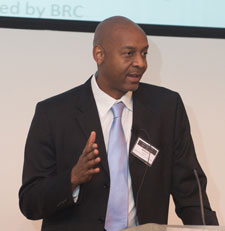BY PATRICK KURP
At the June 4 coming-out party for the electronic Health Research Institute (eHRI), Dr. Robert Satcher, orthopedic oncology surgeon and former NASA astronaut, called for the “democratizing of specialized medical care for all the people of the world.”

Dr. Robert Satcher, orthopedic oncology surgeon and former NASA astronaut, called for the "democratizing of specialized medical care for all the people of the world" at the June 4 summit of eHRI.
Formally organized in April, the eHRI is a collaborative research initiative among the University of Texas MD Anderson Cancer Center (MDA), the Ken Kennedy Institute for Information Technology (K2I) at Rice University and the Center for Space Medicine at the Baylor College of Medicine (BCM). Its aim is to catalyze the advancement and translation of information and communication technology research to enable distance delivery of health care. Co-organizers for the summit at Rice’s BioScience Research Collaborative were the University of Houston College of Optometry and the National Space Biomedical Research Institute (NSBRI).
“This summit brings together outstanding scientists, engineers, physicians, industry innovators and other leaders, all with a focus on networking, advancing, integrating, translating and accelerating research and technology to support and enable distance delivery of specialized health care,” said Jeffrey Sutton in his opening remarks. Sutton is director of the BCM Center for Space Medicine and president, CEO and institute director of NSBRI.
“The goal of eHRI is to work within the academic research institutions across the Texas Medical Center (TMC) to create and support partnerships,” said Jan Odegard, executive director of K2I and, with Satcher, co-director of eHRI. “Such partnerships, with the power to leverage information and communication technology, and the engineering expertise to solve problems, are critical to distance delivery of specialized health care.”
“The summit marks the start of the process but it does not end here,” Odegard said. “The strengths and quality of institutions and researchers across the TMC is unparalleled, and when they are combined with a fast-growing innovation and entrepreneurial community, Houston has an opportunity it cannot afford to fumble.”
Robert Robbins, president and CEO of the TMC, gave his blessings to the summit by expressing the hope that eHRI will “foster fruitful collaborations” among academia, businesses and health care providers. In attendance were representatives of Houston’s “health innovation ecosystem,” a rapidly growing community of small companies run by health care entrepreneurs focused on supporting innovation across the health care spectrum.
One of them, Will Clifton, is co-founder of enventure, a business incubator spawned during a life science entrepreneurship class offered by the Rice Alliance for Technology and Entrepreneurship. “What we’re doing,” he said, “is building a home for medical startups. There doesn’t have to be a vacuum. We offer mentorship, startup capital and a welcoming community.”
Satcher noted that as of 2010, cancer has become the No. 1 killer in the world, surpassing heart disease, and he cited cervical cancer and melanoma as particular focus areas for eHRI research. “We want your time, and we want your investment. Our goals are ambitious. It takes a lot of money to recruit the best researchers and fund such collaborative projects,” Satcher said.
Dr. Kathleen Schmeler, a gynecological oncologist at MDACC, and Benjamin Grant, a fifth-year graduate student in bioengineering at Rice, presented “Global Approaches to Cervical Cancer Screening and Prevention.” Schmeler noted that cervical cancer is the second most common cancer among women and the third most deadly in the world, yet it is “a completely treatable disease.”
Grant demonstrated an optical imaging system developed to improve low-cost, portable cervical cancer screening in developing countries. The device was developed in the lab of Rebecca Richards-Kortum, Rice’s Stanley C. Moore Professor and chair of bioengineering and founder of Beyond Traditional Borders.
Another presentation featured mobileVision, a device permitting untrained individuals to photograph the retina of the eye for remote diagnosis. It was demonstrated by Adam Samaniego, a second-year Rice graduate student in electrical and computer engineering (ECE). He was accompanied by his adviser, Ashutosh Sabharwal, professor of ECE, and Michael Twa, an assistant professor in the College of Optometry at the University of Houston.
Another speaker, Dr. Jesse Selber, a microvascular reconstructive surgeon at MDACC, spoke on “Robotics in Reconstructive Plastic Surgery” and showed videos of robotic surgeries he has performed. “They offer an enormous amount of precision and give remote applications for globalizing specialty care,” he said. “The surgeon will become the quality overseer, the quarterback. We have the technology available today to perform surgery remotely on the other side of the world, but we’re not doing it yet.”
A panel discussion addressed the theme of accelerating technology from research discovery and innovation to commercialization in distance-delivery health care. Satcher said, “We think eHRI is one-of-a-kind, the first of its kind, and its ultimate goal is to help improve access to medical care, especially cancer care, for people around the world.”
The eHRI is pursuing funding and grants to support near-term infrastructure needs, including capital for seed funding to start projects. At the same time, the institute will launch a capital campaign to boost project seed funding and provide long-term sustainable infrastructure support.
Cindy Farach-Carson, Rice’s vice provost for translational bioscience and scientific director of the BRC, said the institute will at first work through the existing institutions’ licensing offices to help commercialize research. But she hopes to develop new licensing models customized for interdisciplinary projects coming out of multiple institutions.
“I think we can really take advantage of the fact that we have 54 institutions here in this entity called the Texas Medical Center, and we can develop new ways for us to get things out of the laboratory and into the clinic,” she said.
The eHRI summit was funded by the John S. Dunn Foundation through the Gulf Coast Consortia, and with support from the Rice University BioScience Research Collaborative.
–Patrick Kurp is a science writer in the George R. Brown School of Engineering.


Leave a Reply